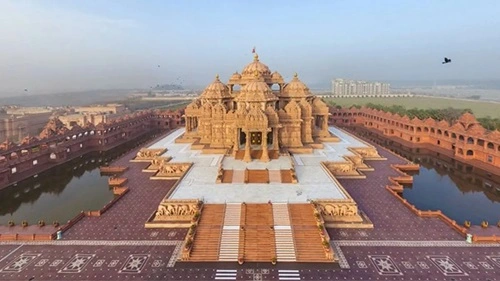Akshardham Temple, also known as Swaminarayan Akshardham, is one of Delhi’s most breathtaking architectural marvels. This massive temple complex, located on the banks of the Yamuna River, is a cultural and spiritual attraction that beautifully showcases Indian art, history, and spirituality. Built by the BAPS Swaminarayan Sanstha and completed in 2005, Akshardham is dedicated to Bhagwan Swaminarayan and serves as a symbol of India’s ancient values and rich heritage.
With its intricate carvings, magnificent central monument, sprawling gardens, and engaging exhibits, Akshardham Temple offers an immersive experience that transports visitors to the grandeur of India’s architectural and spiritual legacy. Planning your visit at the right time can enhance your experience, allowing you to explore the temple’s offerings in comfort. Here’s a guide on the best time to visit Akshardham Temple and what to expect during each season.

Best Seasons to Visit Akshardham Temple
1. Winter (October to March)
Winter is considered the best time to visit Akshardham Temple, as the weather is cool and pleasant, with temperatures ranging from 8°C to 25°C. This comfortable climate makes it ideal for exploring the expansive temple grounds, outdoor exhibitions, and gardens without the discomfort of Delhi’s intense heat or monsoon humidity.
The cooler weather allows visitors to fully appreciate the temple’s grandeur, especially in the afternoons and evenings when the soft sunlight enhances the pink sandstone’s warm tones. Evenings in winter are perfect for enjoying the Sahaj Anand Water Show, an impressive multimedia show that combines water, lights, music, and storytelling to illustrate ancient wisdom and spiritual messages.
During winter, you’ll find the temple complex busier as it’s the peak tourist season. It’s advisable to visit early in the morning or late in the afternoon to avoid the largest crowds. If you’re a photography enthusiast, winter’s clear skies and natural light make for beautiful shots of the temple’s intricate carvings and majestic exteriors.
Additionally, the winter season aligns with various festivals celebrated at Akshardham, including Diwali, Makar Sankranti, and Holi. Special decorations, traditional performances, and rituals are held during these festivals, adding a festive spirit to your visit.
2. Summer (April to June)
Summer in Delhi can be challenging, with temperatures often soaring above 40°C in May and June. While this isn’t the most popular time for tourists, visiting Akshardham in early summer (April) is still feasible, especially if you plan your visit in the early mornings or late evenings when temperatures are relatively cooler.
Despite the heat, summer offers some advantages for those who prefer a quieter experience. The temple complex sees fewer visitors during these months, allowing for a peaceful exploration of its attractions. For those willing to brave the heat, early morning visits offer a calm and uncrowded experience, where you can explore the Hall of Values, Neelkanth Darshan (a giant screen theater), and the boat ride with minimal wait times.
The temple complex is designed to provide shade in certain areas, and indoor attractions are air-conditioned, providing some relief from the heat. However, it’s essential to carry water, wear light clothing, and use sun protection to stay comfortable.
3. Monsoon (July to September)
The monsoon season brings moderate to heavy rainfall to Delhi, creating a refreshing change after the summer heat. Temperatures during this season range between 25°C and 35°C, and the rains add a cool and pleasant feel to the city. While some travelers may be cautious about visiting during monsoon, it’s actually a good time to explore Akshardham Temple, especially in August and September when the rains are lighter.
The monsoon season enhances the temple’s charm, as the rain-washed sandstone glows beautifully against the lush green surroundings. The gardens in the temple complex, including the Yagnapurush Kund and Narayan Sarovar, look particularly scenic during this time, creating a tranquil and picturesque ambiance. Monsoon also brings fewer tourists, allowing visitors to enjoy a quieter experience.
The indoor attractions at Akshardham, such as the exhibitions and theaters, make it easy to explore the temple complex even if there are occasional showers. If you plan to visit during monsoon, check the weather forecast in advance, and carry a light raincoat or umbrella.
Key Attractions and Activities at Akshardham Temple
- Akshardham Mandir: The main temple, or mandir, is the heart of the complex and a stunning example of traditional Indian architecture. The intricate carvings on the sandstone and marble, depicting stories from Hindu mythology, make the temple a visual marvel.
- Sahaj Anand Water Show: Held in the evenings, the Sahaj Anand Water Show is a mesmerizing mix of lights, sound, and water effects. The show uses multimedia to narrate a timeless story with spiritual messages, offering a memorable experience for visitors of all ages.
- Yagnapurush Kund and Musical Fountain: The Yagnapurush Kund, the world’s largest stepwell, is a magnificent sight and a peaceful place to sit and reflect. The musical fountain here lights up in the evening, providing a beautiful display synchronized with classical music.
- Hall of Values (Sahajanand Darshan): This exhibition showcases the teachings and values of Swaminarayan through animatronic displays, dioramas, and storytelling. It is an inspiring journey, especially for visitors interested in learning about India’s spiritual heritage.
- Cultural Boat Ride: The 12-minute boat ride takes visitors on a journey through India’s 10,000-year history, featuring scenes of ancient civilizations, Vedic culture, and prominent historical figures. This attraction is especially popular among families and children.
- Garden of India (Bharat Upavan): The landscaped gardens feature bronze statues of notable Indian figures, including warriors, saints, and philosophers, celebrating India’s diversity and heritage. It’s an ideal spot for a peaceful stroll after exploring the temple’s main attractions.
Practical Tips for Visiting Akshardham Temple
- Timings: The temple is open from Tuesday to Sunday, with entry from 10:00 AM to 6:00 PM. The temple remains closed on Mondays. The water show typically takes place after sunset, so plan your visit accordingly.
- Security and Prohibited Items: Strict security measures are in place, and electronic devices, cameras, and bags are not allowed inside. Lockers are available for visitors to store their belongings.
- Dress Code: Visitors are expected to dress modestly out of respect for the religious site. Ensure your attire covers your shoulders, arms, and knees.
- Food and Water: There is an on-site cafeteria serving vegetarian food. Outside food and water are not allowed, so you can plan to enjoy a meal or snack at the temple’s food court.
- Photography: Photography is prohibited within the temple complex. However, the beauty of Akshardham Temple is unforgettable, even without photos, and you can take in every detail by fully engaging in the experience.
Conclusion
Akshardham Temple is a breathtaking testament to India’s architectural and spiritual heritage. From the vibrant winters with festive celebrations to the peaceful monsoon atmosphere and serene summer mornings, each season brings a unique aspect to your visit. Whether you’re drawn by the temple’s spiritual ambiance, cultural exhibitions, or the mesmerizing water show, planning your trip according to the best time will make it an unforgettable experience. Step into the grandeur of Akshardham, where India’s past and present blend harmoniously, and take away a sense of peace, inspiration, and wonder.


